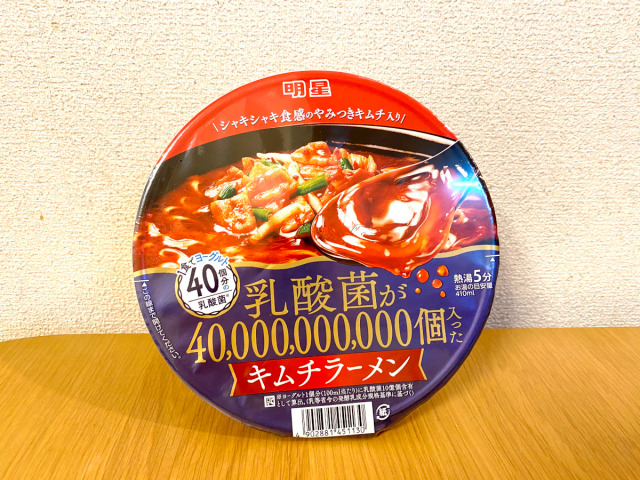
I demand a recount!
With so many varieties of instant noodles on the market, it can be very hard to stand out. Even its leader Cup Noodle strives to be increasingly outlandish, making it that much harder for competitors to get noticed. Meisei, however, may have found an in with their new Kimchi Ramen with 40,000,000,000 Lactic Acid Bacteria.
Released on 23 November, this spicy soup is hoping to cash in on the wild popularity of other lactic-acid-bacteria-rich Japanese products in the past. They are also taking things one step further by providing an estimated bacterium population on the label.
It’s a neat trick, because why say your food has “such-and-such grams” of a nutrient when you can say it has “BILLIONS of molecules” of it instead?
However, people in other countries might not be so familiar with the appeal of lactic acid bacteria that seems to drive Japanese consumers wild. In fact, our taste-tester P.K. Sanjun wasn’t sure either, so he consulted the Ministry of Health, Labor and Welfare website to learn more about it.
“Lactic acid bacteria play a role in suppressing the growth of harmful bacteria such as E. coli in the intestine and balances intestinal bacteria levels. It is said to not only improve bowel movements, but also lower cholesterol and enhance immunity against cancer. Lactic acid bacteria’s role in eliminating H. pylori infections in the stomach is also currently being studied.”
[Ministry of Health, Labor and Welfare]
Sounds great, but there’s also the question of whether 40 billion bacteria is actually a lot, considering they’re microscopic. So, to clarify, Meisei wrote on the package that one bowl of their new Kimchi Ramen has the same amount of lactic acid bacteria as 40 cups of yogurt.
P.K. was intrigued at what such a bacteria-ridden ramen might taste like, so he happily paid the 230 yen (US$2.20) price of admission and started boiling some water. The contents were underwhelmingly similar to a regular instant noodle kit with dried noodles, toppings, and sauces. No pulsating packages of 40 billion bacteria, or anything to even suggest such.
Once completed, there still was nothing distinguishing this from an ordinary bowl of kimchi ramen. Even though bacteria are invisible to the naked eye, so many in such a small space would make their presence known somehow, wouldn’t they?
Even while eating, there was nothing outstandingly different about this ramen. It was tasty, but well in the neighborhood of other instant ramens. P.K. had thought that for sure the lactic acid bacteria would have given it a milkier taste or texture, but nothing out of the ordinary could be detected.
Still, as he ate, P.K. knew he was getting a heap of healthy bacteria, and that motivated him to keep eating. He even drank the last drop of broth, just in case those little things were hiding in there.
All in all, in wasn’t anything amazing, but that’s par for the course with instant ramen. And while you might say that this product isn’t about the taste but the health benefits, P.K. couldn’t help but think that you could get the same amount of lactic acid bacteria in a simple little bottle of the drink Yakult 400.
However, if you want your 40 billion bacteria and to eat kimchi ramen too, this product has all your bases covered. Considering the bacteria help promote smooth bowel movements, they ought to conveniently counteract the kimchi in that regard.
P.K. was far too modest to tell us if that was the case or not though. Maybe we’ll ask one of our more forthcoming reporters to describe that end of the experience later on.
Source: Meisei, Ministry of Health, Labor and Welfare
Photos ©SoraNews24
● Want to hear about SoraNews24’s latest articles as soon as they’re published? Follow us on Facebook and Twitter!
[ Read in Japanese ]

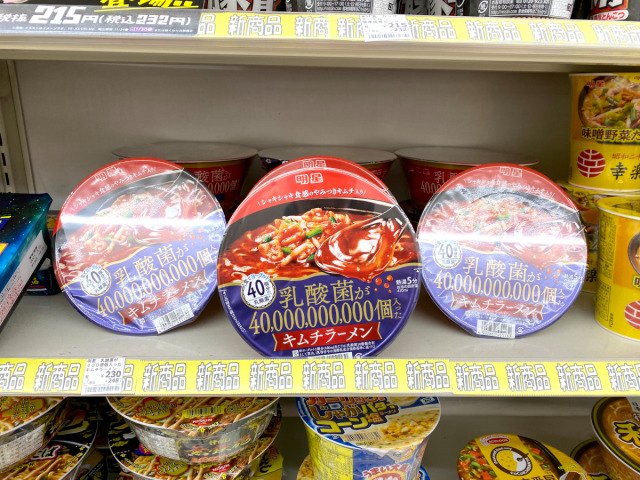
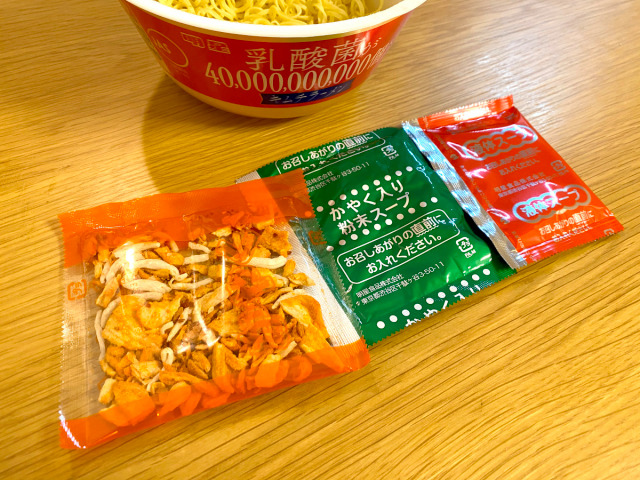
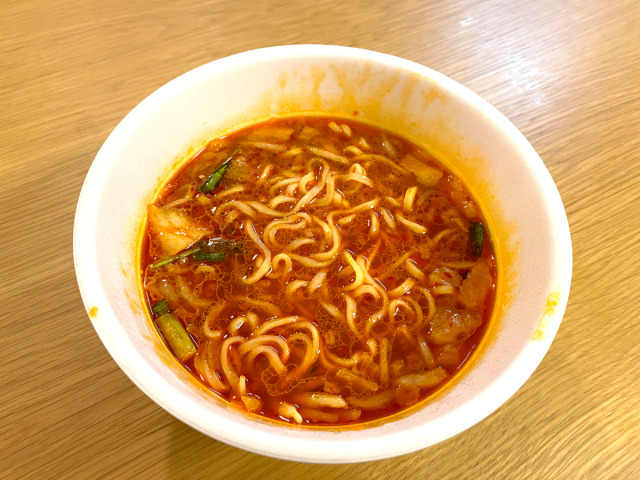
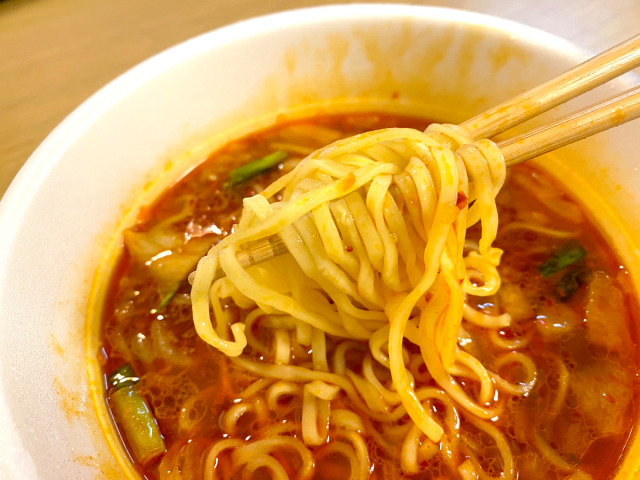
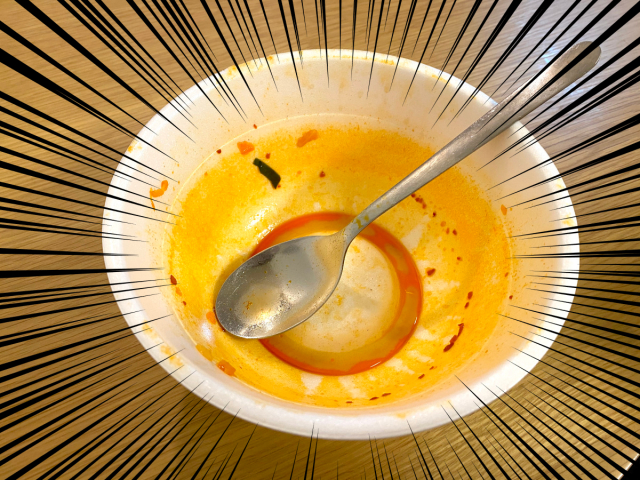
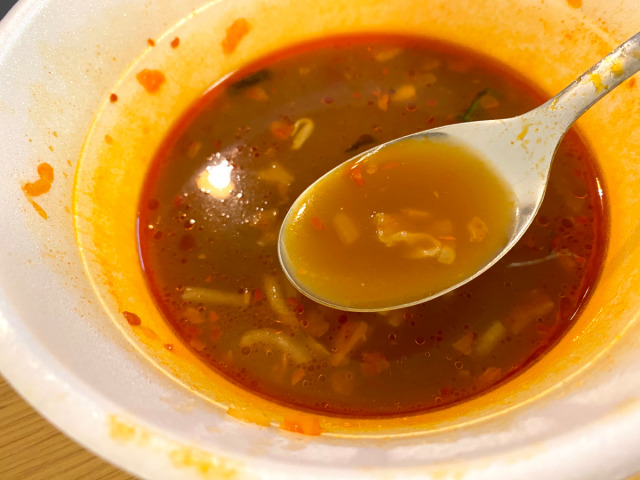
 Japan’s first-ever Yakult cafe serves a rare probiotic ice cream in the shadow of a famous castle
Japan’s first-ever Yakult cafe serves a rare probiotic ice cream in the shadow of a famous castle Yakult opens a dessert store in Japan and releases a new ice cream in supermarkets
Yakult opens a dessert store in Japan and releases a new ice cream in supermarkets Chuka Zanmai instant ramen offering ultra luxurious limited-edition two-meal seat for $50
Chuka Zanmai instant ramen offering ultra luxurious limited-edition two-meal seat for $50 Man arrested for stealing a pack of lactic acid drinks from Osaki City Hall
Man arrested for stealing a pack of lactic acid drinks from Osaki City Hall Japanese sake breaks new ground with a variety specially blended to pair well with chocolate
Japanese sake breaks new ground with a variety specially blended to pair well with chocolate How to order snacks on a Shinkansen bullet train in Japan
How to order snacks on a Shinkansen bullet train in Japan New Nintendo Lego kit is a beautiful piece of moving pixel art of Mario and Yoshi【Photos】
New Nintendo Lego kit is a beautiful piece of moving pixel art of Mario and Yoshi【Photos】 Demon Slayer: Kimetsu no Yaiba gets new roller coaster attractions and food at Universal Studios Japan
Demon Slayer: Kimetsu no Yaiba gets new roller coaster attractions and food at Universal Studios Japan New samurai glasses are Japan’s latest weird must-have souvenir
New samurai glasses are Japan’s latest weird must-have souvenir Finally! Nintendo Japan expands Switch 8-bit controller sales to everybody, Online member or not
Finally! Nintendo Japan expands Switch 8-bit controller sales to everybody, Online member or not Apartment in Japan explodes following bizarre series of events【Video】
Apartment in Japan explodes following bizarre series of events【Video】 McDonald’s adds a new Cheese Bacon Potato Pie to its menu in Japan for a limited time
McDonald’s adds a new Cheese Bacon Potato Pie to its menu in Japan for a limited time Nintendo history you can feel – Super NES, N64, and GameCube controllers become capsule toys
Nintendo history you can feel – Super NES, N64, and GameCube controllers become capsule toys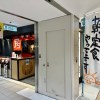 Tokyo Station’s perfect breakfast spot might just be this izakaya Japanese-style pub
Tokyo Station’s perfect breakfast spot might just be this izakaya Japanese-style pub High-fashion Totoro cuddle purse is like an elegant stroll in the forest【Photos】
High-fashion Totoro cuddle purse is like an elegant stroll in the forest【Photos】 Hello, cosmetics! Clinique teams up with Hello Kitty this summer for first-time collaboration
Hello, cosmetics! Clinique teams up with Hello Kitty this summer for first-time collaboration “The most Delicious Cup Noodle in history” – Japan’s French Cup Noodle wins our heart【Taste test】
“The most Delicious Cup Noodle in history” – Japan’s French Cup Noodle wins our heart【Taste test】 Starbucks releases a cute Frappuccino and Unicorn Cake…but not in Japan
Starbucks releases a cute Frappuccino and Unicorn Cake…but not in Japan Kyoto Tower mascot termination reveals dark side behind cute Japanese characters
Kyoto Tower mascot termination reveals dark side behind cute Japanese characters McDonald’s Japan’s Soft Twist Tower: A phantom ice cream only sold at select branches
McDonald’s Japan’s Soft Twist Tower: A phantom ice cream only sold at select branches Yabai Ramen: What makes this Japanese ramen so dangerous?
Yabai Ramen: What makes this Japanese ramen so dangerous? Japanese government wants to build luxury resorts in all national parks for foreign tourists
Japanese government wants to build luxury resorts in all national parks for foreign tourists To combat declining birth rate, Japan to begin offering “Breeding Visas” to foreigners
To combat declining birth rate, Japan to begin offering “Breeding Visas” to foreigners 10 things you should buy at 7-Eleven in Japan
10 things you should buy at 7-Eleven in Japan Studio Ghibli releases anime heroine cosplay dresses that are super comfy to wear
Studio Ghibli releases anime heroine cosplay dresses that are super comfy to wear Woman charged for driving suitcase without a license in Osaka
Woman charged for driving suitcase without a license in Osaka Studio Ghibli unveils My Neighbour Totoro miniature house model
Studio Ghibli unveils My Neighbour Totoro miniature house model Kyoto experiencing problems with foreign tourists not paying for bus fares, but not on purpose
Kyoto experiencing problems with foreign tourists not paying for bus fares, but not on purpose Fighting mild hunger with a Japanese soda that turns into jelly in the stomach【Taste test】
Fighting mild hunger with a Japanese soda that turns into jelly in the stomach【Taste test】 Studio Ghibli’s Howl’s Moving Castle tapestry unveiled in Japan for first time
Studio Ghibli’s Howl’s Moving Castle tapestry unveiled in Japan for first time McDonald’s new Happy Meals offer up cute and practical Sanrio lifestyle goods
McDonald’s new Happy Meals offer up cute and practical Sanrio lifestyle goods Sales of Japan’s most convenient train ticket/shopping payment cards suspended indefinitely
Sales of Japan’s most convenient train ticket/shopping payment cards suspended indefinitely Sold-out Studio Ghibli desktop humidifiers are back so Totoro can help you through the dry season
Sold-out Studio Ghibli desktop humidifiers are back so Totoro can help you through the dry season Japanese government to make first change to romanization spelling rules since the 1950s
Japanese government to make first change to romanization spelling rules since the 1950s Foreigner’s request for help in Tokyo makes us sad for the state of society
Foreigner’s request for help in Tokyo makes us sad for the state of society Ghibli founders Toshio Suzuki and Hayao Miyazaki contribute to Japanese whisky Totoro label design
Ghibli founders Toshio Suzuki and Hayao Miyazaki contribute to Japanese whisky Totoro label design Doraemon found buried at sea as scene from 1993 anime becomes real life【Photos】
Doraemon found buried at sea as scene from 1993 anime becomes real life【Photos】 Tokyo’s most famous Starbucks is closed
Tokyo’s most famous Starbucks is closed Princesses, fruits, and blacksmiths: Study reveals the 30 most unusual family names in Japan
Princesses, fruits, and blacksmiths: Study reveals the 30 most unusual family names in Japan PewDiePie tries “every” Japanese snack and this is how people in Japan reacted to it
PewDiePie tries “every” Japanese snack and this is how people in Japan reacted to it The LifeStraw can make all kinds of water drinkable, but does it work on urine? 【Video】
The LifeStraw can make all kinds of water drinkable, but does it work on urine? 【Video】 Instant vs. Restaurant Ramen Project: Ippudo spicy miso tonkotsu battle【Taste test】
Instant vs. Restaurant Ramen Project: Ippudo spicy miso tonkotsu battle【Taste test】 The twin joys and dual sadnesses of eating ramen in the U.S.
The twin joys and dual sadnesses of eating ramen in the U.S. McDonald’s Japan offering Calpis shakes this summer with new-and-improved recipe
McDonald’s Japan offering Calpis shakes this summer with new-and-improved recipe Nissin’s Cup Noodle gets glamorous birthday makeover!
Nissin’s Cup Noodle gets glamorous birthday makeover! Japan gets a new Fanta for a limited time
Japan gets a new Fanta for a limited time Research from Japanese university claims kissing pets can cause stomach cancer
Research from Japanese university claims kissing pets can cause stomach cancer Alien Ramen: In space no one can hear you complain…
Alien Ramen: In space no one can hear you complain… Japanese team wins Ig Nobel prize for confirming that banana peels are in fact slippery
Japanese team wins Ig Nobel prize for confirming that banana peels are in fact slippery Make your tummy happy, eat a kimchi yogurt rice bowl today
Make your tummy happy, eat a kimchi yogurt rice bowl today Why is it so hard to find hot sake in convenience stores in Japan?
Why is it so hard to find hot sake in convenience stores in Japan? Asahi Brewery asks: Why not mix beer and Calpis? So we do…
Asahi Brewery asks: Why not mix beer and Calpis? So we do… We tried making natto the old-fashioned way, and the result was unexpected but delicious 【SoraKitchen】
We tried making natto the old-fashioned way, and the result was unexpected but delicious 【SoraKitchen】 Mint chocolate tapioca ramen appears in Tokyo: Too much to handle or too good to believe?
Mint chocolate tapioca ramen appears in Tokyo: Too much to handle or too good to believe? Japan’s first-ever wanko soba conveyor belt restaurant opens in Tokyo
Japan’s first-ever wanko soba conveyor belt restaurant opens in Tokyo
Leave a Reply